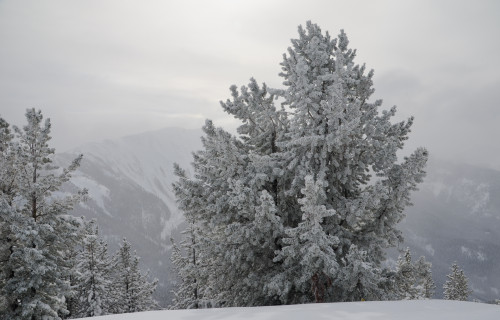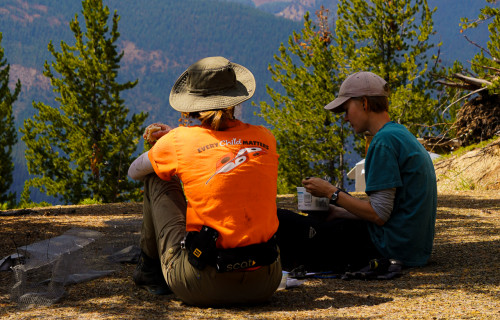Whitebark Pine
In 2023 Panorama became a certified Whitebark Friendly Ski Area by the Whitebark Pine Ecosystem Foundation of Canada. Learn more about these unique trees that live in our alpine and the ongoing work being done to protect this threatened species.
Learn more
About the Species
What is the Whitebark Pine?
If you have visited our summit, you may not realize that you are surrounded by this remarkable tree that plays a vital role in the health of our mountain.
Found across the subalpine of interior BC, Alberta and parts of the U.S., this slow-growing pine is easily identifiable by its bundles of five individual needles — similar to other species like the limber and western white pine. In comparison, the lodgepole pine at Panorama are two-needle pine trees, with two needles per bunch.
Able to withstand the harshest of conditions, these trees grow at the highest treeline elevations helping to protect the snowpack, regulate snowmelt and prevent erosion on steep and rocky slopes.
The tree provides much-needed shelter in its harsh alpine habitat and essential nutrients that many animals rely on, from Grizzly bears to the Clark's Nutcracker which has a unique symbiotic relationship with this tree species.

Role in the Ecosystem
Why are they so important?
The whitebark provides a uniquely rich source of nutrition to alpine wildlife. Dense with fat, carbohydrates and protein, the large seeds of a whitebark pine are a high-quality and long-lasting food source that is highly sought after by many animals in the alpine ecosystem.
The Clark's Nutcracker and the whitebark have a symbiotic relationship. The cones provide the bird's primary food source, and in return the Nutcracker disperses the seeds by storing them in the ground. Some of the stashed seeds eventually germinate resulting in new trees.
Larger animals also rely on the whitebark as part of their diet, including Black and Grizzly bears. In years when the trees produce fewer cones, evidence shows the shortage can significantly impact bear survival.
The whitebark pine also provides a much-needed source of shelter for wildlife living at high alpine altitudes. Their canopies also provide shade that helps to slow the melting of the snowpack and regulates snowmelt throughout the winter and spring, impacting the greater health of the watershed.
Expansive and deep root systems help to stabilise the steep and often rocky terrain that the trees are found in, helping to maintain the landscape.

Environmental Threats
What is happening to the Whitebark Pine?
Over the past decade, whitebark pine numbers have fallen dramatically, due in large part to a non-native fungal disease known as white pine blister rust, alongside other environmental factors. The whitebark pine is classified as an endangered species under the Government of Canada's Species at Risk Act (SARA), and has recently been added to the U.S. Fish and Wildlife Service's threatened species list.
Blister rust has a high mortality rate for the trees, with the highest infection levels occurring in southwestern Canada and the northwestern U.S. Blister rust is identifiable by the red tinge around the main stem of the tree that slowly extends and eventually kills the entire tree.
Other environmental threats to the whitebark pine include the mountain pine beetle, which in conjunction with the blister rust can drastically impact the species ability to regenerate, and in highly damaged ecosystems, the majority of the seeds are consumed by animals rather than dispersed.

Conservation & Support Efforts
What is Panorama doing?
Panorama has collaborated with the Whitebark Pine Ecosystem Foundation of Canada to facilitate restoration projects including cone collection and tree plantings within our ski area.
For more than 20 years, Panorama has participated in cone caging and collection projects with the Whitebark Pine Ecosystem Foundation to protect a select amount of cones on healthy trees from being eaten by wildlife. The cones are caged during the summer months to protect them during their growth, and at the end of the season are collected to help propagate seedlings that are then used to help repopulate damaged stands and aid in the natural regeneration process of the ecosystems.
In 2021, 5,000 whitebark pine seedlings were planted in a permanently closed area within Panorama's ski boundary known as Canadian Bowl. Plantings like this are the future of whitebark pine. The project was made possible by funding from the BC Government's Forest Carbon Initiative.
Mature trees are currently monitored for resistance to the whitebark pine blister rust. So far, at least one tree at Panorama has been found.

















